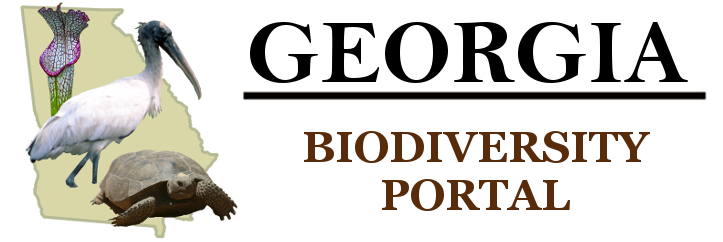The Wildlife Conservation Section maintains records for rare species and communities in our conservation databases. We track species and natural communities that are protected at state and federal levels or not legally protected but are considered of special conservation concern by our staff biologists. Use the bookmark links below to navigate this page.
View Our Data
About Our Data
Please keep in mind the limitations of our database. The data collected by the Wildlife Conservation Section comes from a variety of sources, including museum and herbarium records, literature, reports from individuals and organizations, as well as field surveys by our staff biologists. In most cases the information is not the result of a recent on-site survey by our staff. Many areas of Georgia have never been surveyed thoroughly. Our files are updated constantly as new information is received. Thus, information provided by our program represents the existing data in our files on the date indicated on these pages and should not be considered a final statement on the species or area under consideration.
Current Public Data

Please visit our new Georgia Biodiversity Portal. The latest rare species and natural community data can now be accessed from this data portal page. Included are rare species profiles, range maps, and rarity ranks as well as state and federal protection statuses. Also included are lists of rare species by Georgia county, quarter quad, watershed, ecoregion and more. Although the most up-to-date information can be found on the portal, you can also view the 2011 version of natural community thumbnail accounts as a pdf here: Georgia's Natural Communities and Associated Rare Plant and Animal Species: Thumbnail Accounts.
Request Data for Environmental Review
Please view instructions on our Environmental Review webpage.
Submit Rare Species Data to Our Program
Do you know the location of an exemplary or relatively undisturbed natural community? Do you have site information for a rare species? Once we receive your information, it will be verified and entered into our database. The information will be used to update species range maps, identify and develop recommendations for the protection of species that could be impacted by development, and for general conservation planning purposes.
Data Submission Forms
We prefer to receive data electronically when possible, especially for large data sets, as it can greatly speed up our work adding the information to our database. Please see our different data submission forms below. Inclusion of photo evidence is preferred. To help reduce errors, providing a map is also highly recommended, either as a GIS layer or marked topographic or imagery map.
If you have reported rare species data as part of a scientific collecting permit report, you do not need to report that data separately to our program. If you are a permittee, please submit any supplemental data at the end of the permit year after data quality control procedures have been completed. In some cases, we may ask for additional information to verify your data (e.g. a photograph of the specimen or habitat).
- Plant data forms:
- Electronic or print version: Plant data collection form. You can either email the form directly, or you can print it then scan or mail it. Our mailing address and email address can be found in the Contacts section below.
- Animal data forms:
- Electronic version: Animal Excel spreadsheet (includes examples) or Survey123. Please send the Excel via email. For Bat data specifically: Bat Excel spreadsheet. Also, please visit our Bat Survey Guidance page for more information about current survey requirements in Georgia.
- Print version: Animal data collection form. You can either email the form directly, or you can print it then scan or mail it. Our mailing address and email address can be found in the Contacts section below.
If you have questions about submitting data, please contact us. Our email address can be found in the Contacts section below.
Data Formatting
It is important that data is submitted in a consistent format for ease of conversion and integration into our database. This is especially true for the date, scientific name, latitude and longitude fields. Examples of often encountered inconsistencies include latitude and longitude in differing formats such as decimal degrees ("e.g.: Lat 32.2354") and degrees minutes seconds ("e.g.: Lat 32⁰ 27’ 13") in the same data set. All latitude and longitude values should also use the same datum, (e.g. either NAD27 or NAD83, but not both in the same data set). If you will be submitting your data in a projected coordinate system, please use UTM Zone 16 or 17 NAD83 as appropriate for the area. We also accept coordinates in WGS 84. If you submit a GIS layer or shapefile to us, we can check for the projection and datum used.
With dates, the preferred format to use is year, month, day such as "2004-06-13" for June 13, 2004, but any consistently used format can be readily converted during the import process.
Contact
Our email address is: gabiodata@dnr.ga.gov.
Our physical and mailing address is:
Georgia Department of Natural Resources
Wildlife Conservation Section
Wildlife Resources Conservation Center
2065 U.S. Hwy 278 SE
Social Circle, GA 30025-4743



















